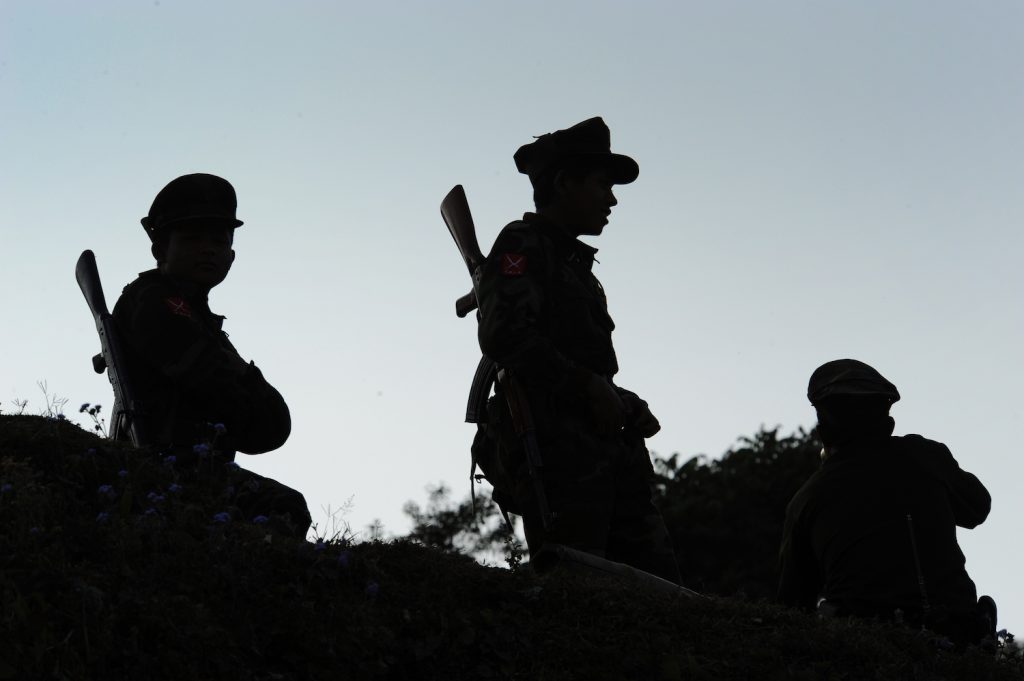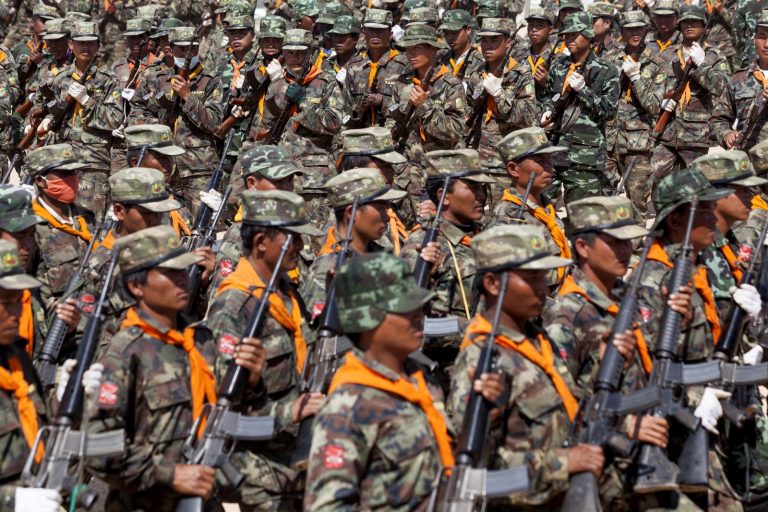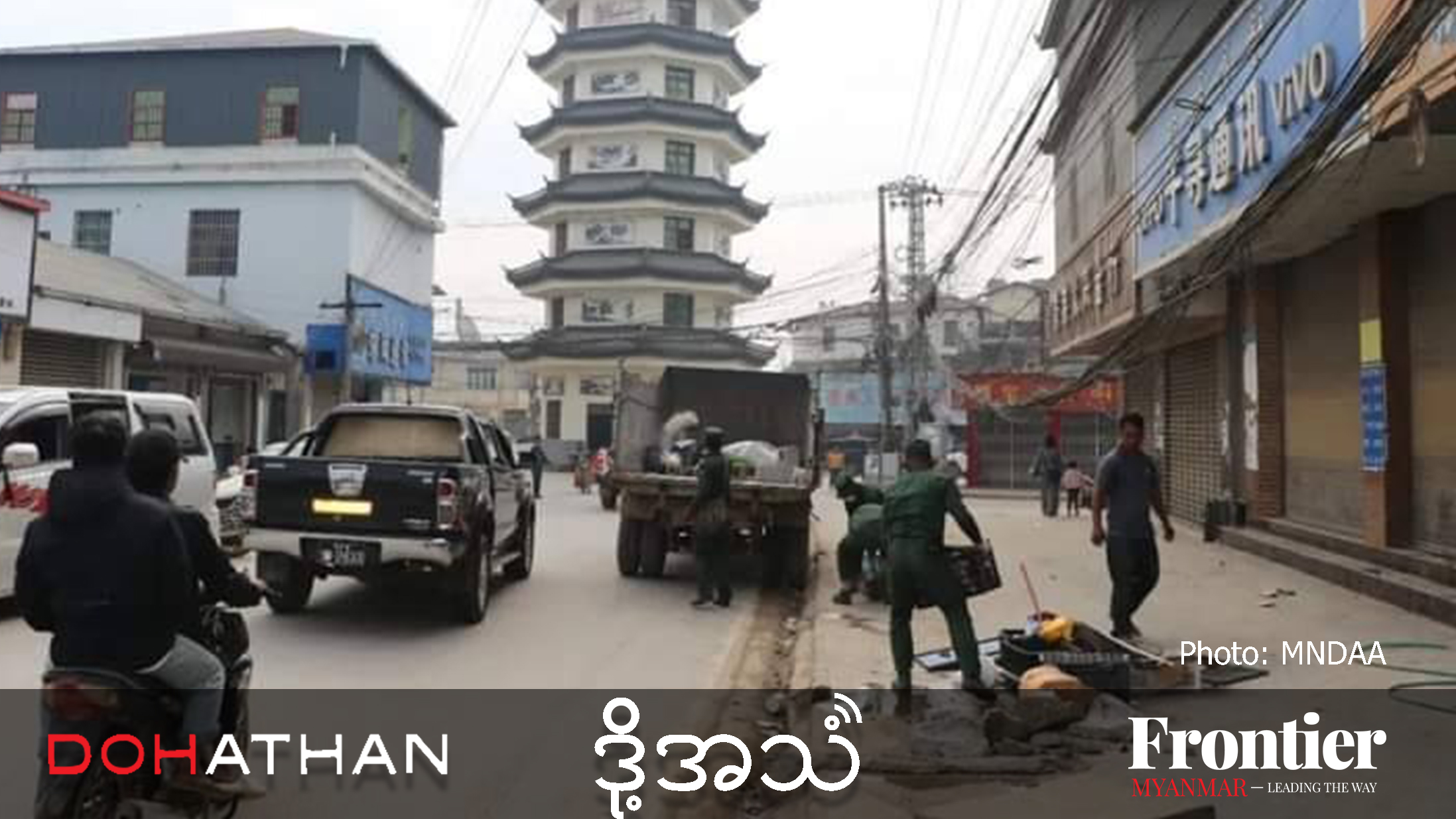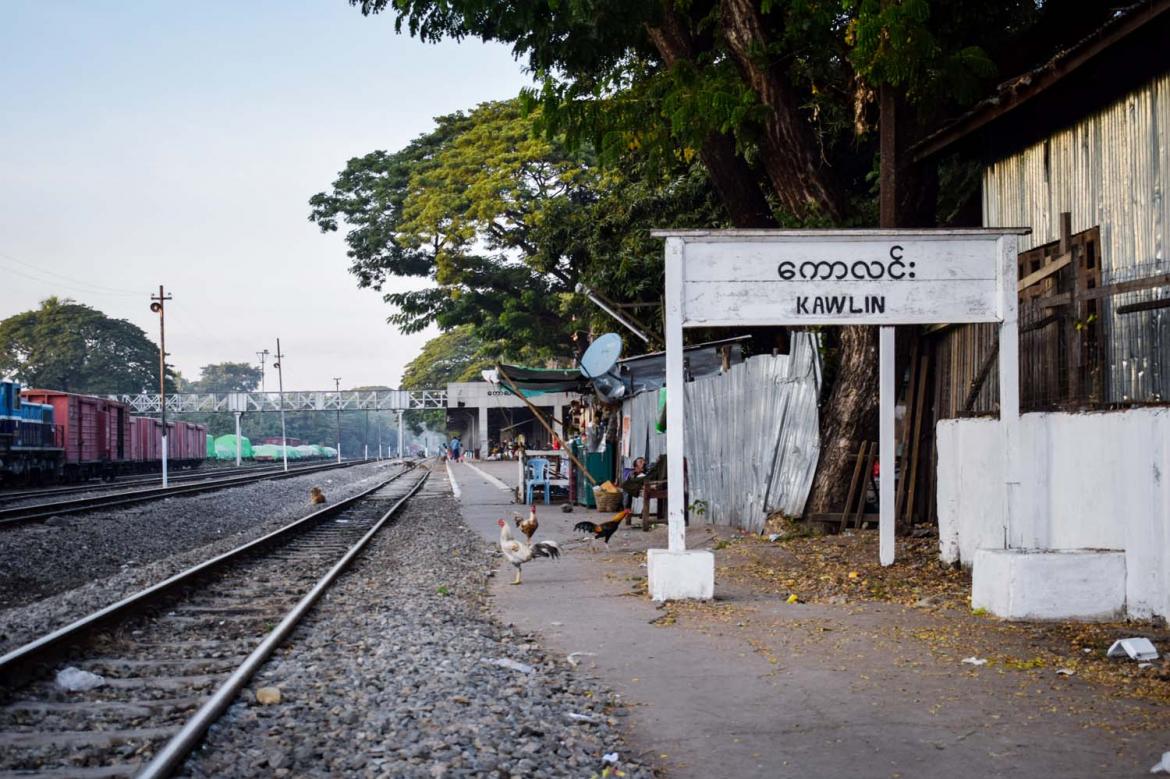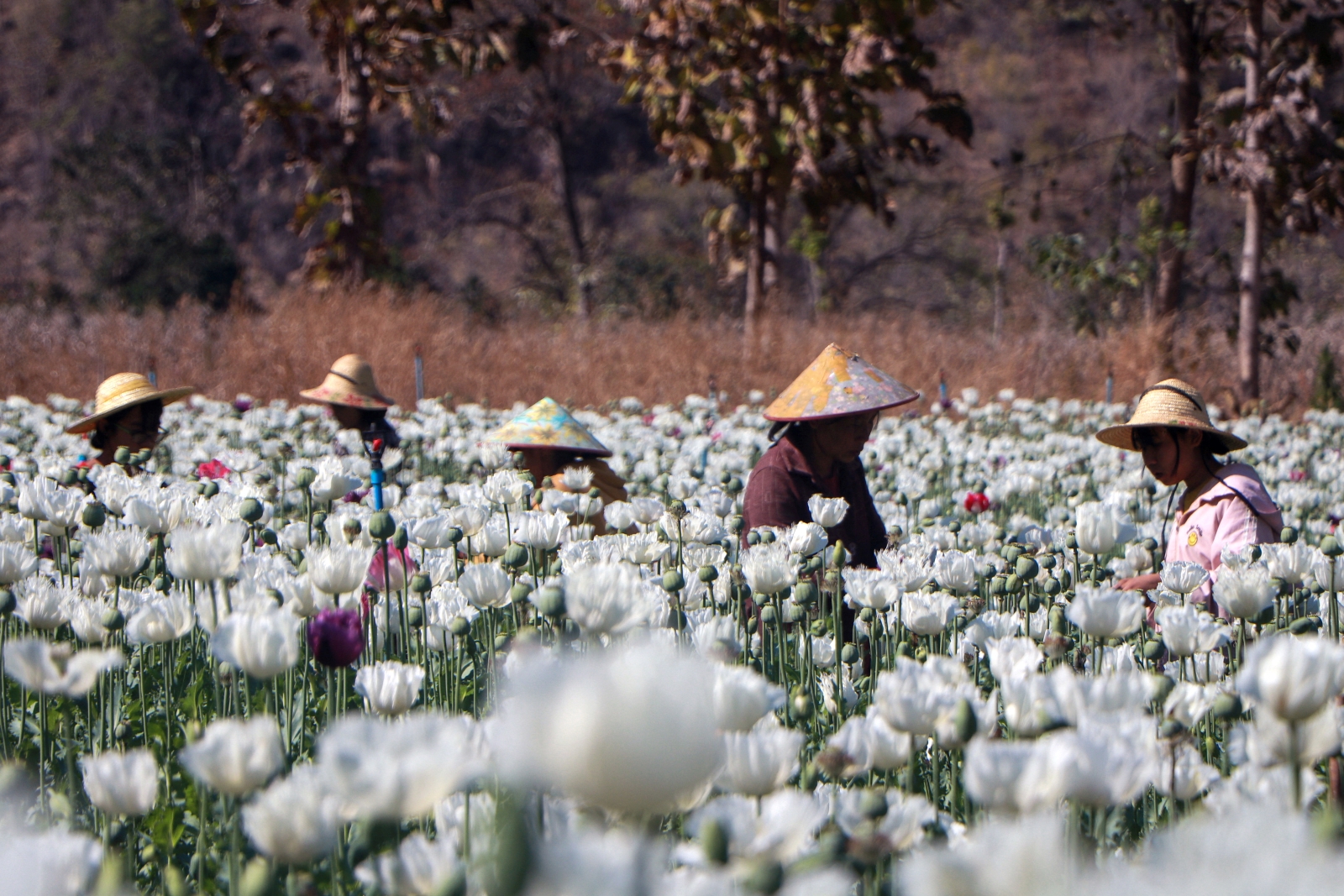The Ta’ang National Liberation Army and Kachin Independence Army have fought side by side for decades, but recent abuses against civilians underscore how communal relations in northern Shan State are shifting as the Ta’ang armed group grows ever stronger.
By LAWI WENG | FRONTIER
Through the evening darkness, La San spotted a man jump the fence into his compound and begin approaching his house. When La San went outside to investigate, he found another man standing at the gate to his house. When the man at the gate refused his offer to come inside, La San realised he was there to stand guard. “We’re here to check for drugs,” the other man said. La San then recognised both of them: they were from his village – Galeng, in northern Shan State’s Kutkai Township – and were known to be members of the Ta’ang National Liberation Army.
La San let the man into his house. During the search, the man found inside a cigarette packet some pieces of silver paper that is often used when smoking crushed methamphetamine tablets known as yaba. “You’re using this to smoke drugs,” the TNLA member said, accusingly. La San insisted that it was his older brother’s cigarette packet, and they got into an argument. “If you think that’s mine, then go on, hit me,” La San said.
The man hit him about 10 times, La San said, striking him on his face and body. When La San’s terrified wife discovered what was happening, she tried to call a friend to come and help, but before she could the soldier punched her in the face. La San said that during the whole ordeal he never fought back.
“I have heard about others who fought back [against TNLA members] without realising they were carrying guns and then were shot, so I didn’t dare to fight back,” he said. “If he was just a normal civilian, I would never let him beat me or my wife. I would fight back for sure.”
Since it emerged a decade ago, the TNLA has made drug eradication one of its central goals, destroying opium fields and employing harsh techniques to force civilians to quit using in a region awash with drugs. It was a policy that La San supported. “I think it has been very good for our community,” said the 21-year-old Kachin man.
But in this case, La San said the TNLA members did not follow the usual procedure of bringing the village administrator to search the house of a suspect for illicit drugs. “The two soldiers were drunk and they didn’t inform the administrator, they just raided my house and beat me,” he said. “It was very unprofessional.”
The same day that the TNLA members accosted La San, Kachin Independence Army members abducted Lway Poe, a 16-year-old Ta’ang girl from Yong Ma village in Kutkai. (Lway Poe is not her real name.)
The men had come looking for her father, who they said had deserted from the KIA. When he wasn’t home, they took Lway Poe instead, figuring they could use her as leverage to get her father to rejoin the group’s ranks.
The soldiers took Lway Poe on a motorbike to a Kachin village in Kutkai, where she stayed for two weeks. After some Ta’ang rights groups and the TNLA drew attention to her case, the KIA released her and she was sent back to her village, she told Frontier by phone.
But when they released Law Poe, the KIA members warned that they could come and arrest her again at any time – a prospect that continues to fill her with terror. Her father, too, does not dare come back to the village, she said.
Although her fear was palpable, all she would say was, “They treated me well and they did not beat me.”
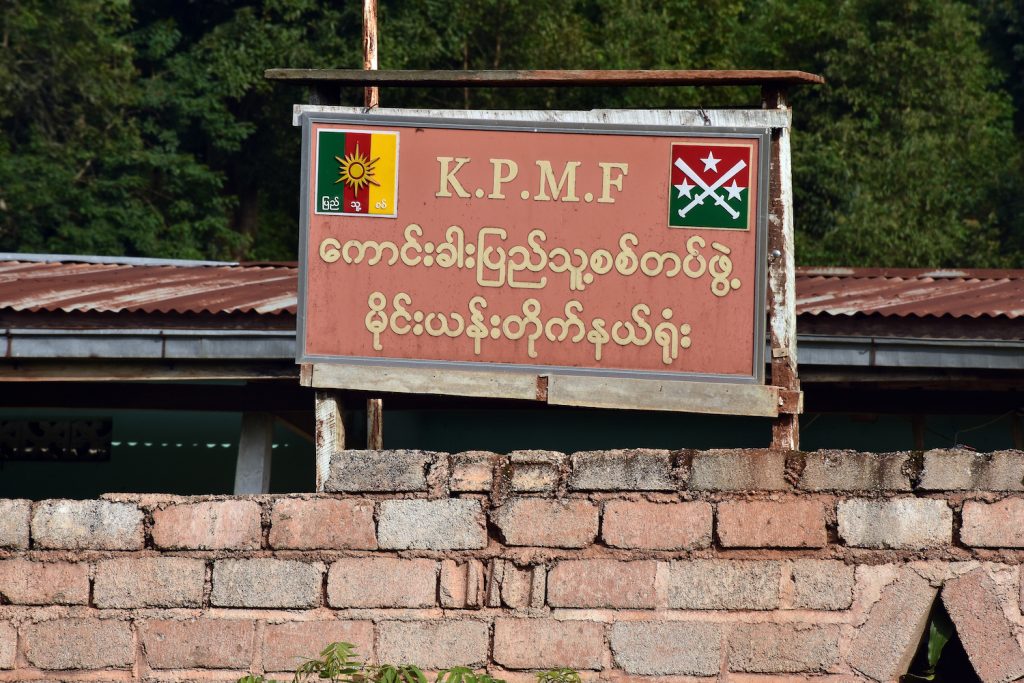
Defusing ethnic tensions
News of these two incidents spread rapidly through social media, with Kachin civil society organisations drawing attention to the beating of La San and his wife and condemning the actions of the TNLA.
Similarly, when news of the 16-year-old girl’s kidnapping emerged, many Ta’ang rights groups condemned the KIA soldiers’ actions and called for her release.
But the complaints on both sides were mostly restrained. The Kachin National Congress, a political party, issued a statement with details about La San’s incident and urged the TNLA to check more carefully whether people are actually connected to illicit drugs when carrying out their anti-narcotics campaigns.
The apparent reluctance to criticise the TNLA directly while still drawing attention to the incident reflects an awareness that ethnic tensions between the Ta’ang and Kachin could escalate easily in Kutkai and other parts of northern Shan State.
In a region that has seen almost constant armed conflict since independence, the two ethnic groups have co-existed relatively peacefully, in part thanks to longstanding cooperation between the KIA and the TNLA, as well as earlier Ta’ang armed groups.
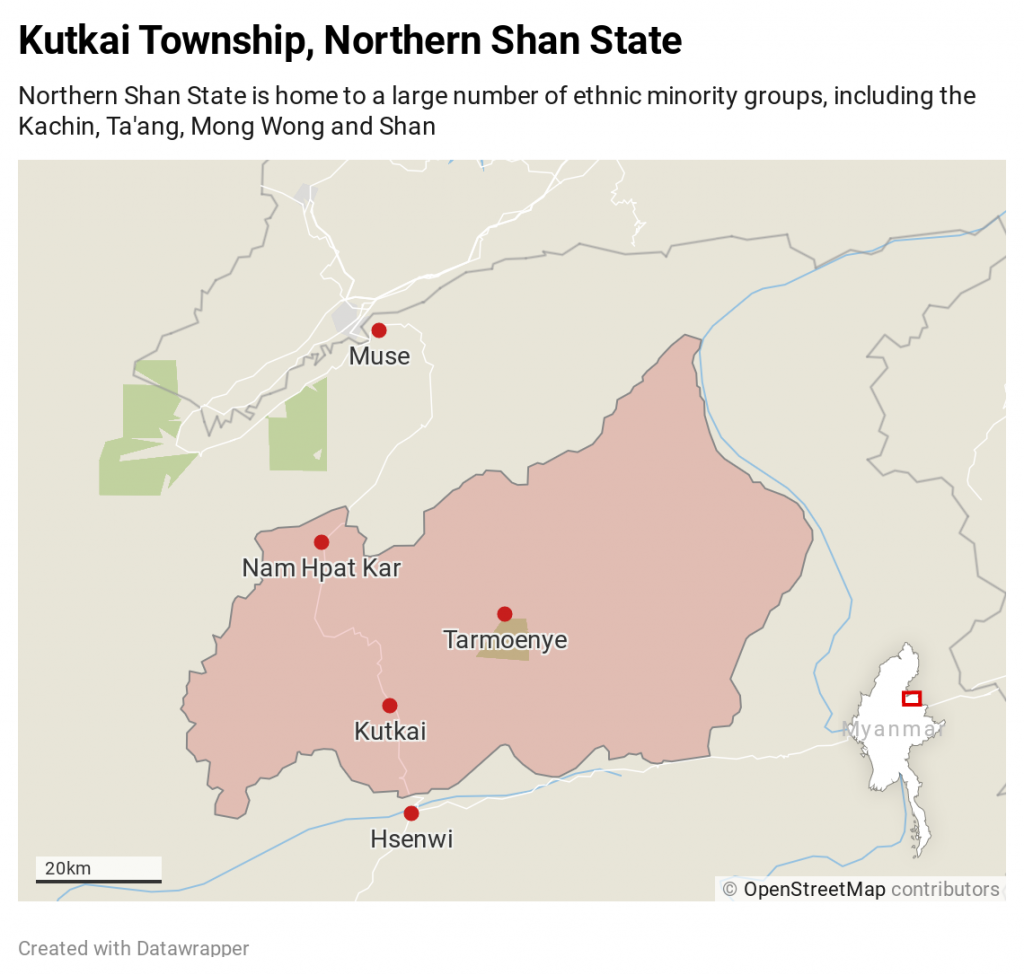
Many villages in Kutkai are mixed, home to both Kachin and Ta’ang. Some are in territory nominally controlled by the KIA, and others in areas under the influence of the TNLA – but often KIA and TNLA territory overlaps. This intermixing creates positive communal relations, but can lead to tensions when an ethnic armed group tries to enforce policies on members of a different ethnicity.
General Administration Department figures show that the Ta’ang (officially referred to as the Palaung) make up 24.5 percent of the population in Kutkai, and the Kachin comprise 23.5pc. The Mong Wong, a Mandarin-speaking group, are the largest at 28.6pc, while Shan comprise 7.8pc.
While the figures should be treated with caution, as they do not reflect people of mixed ancestry, they reflect the region’s ethnic diversity, and why ethnic leaders are keen to prevent tensions from escalating.
Thrown into this ethnic mix is a slew of non-state armed groups, including not only the KIA and TNLA, but also pro-Tatmadaw militias, including the Mong Wong’s Tarmoenye militia, and the ethnic Kachin Kutkai and Kaungkha militias. Virtually all claim to represent or protect a particular ethnic group in the region.
Residents of northern Shan State have already seen how ethnic relations can quickly fall apart, particularly when tensions rise between armed groups. Shortly after the Restoration Council of Shan State signed the Nationwide Ceasefire Agreement in October 2015, it began shifting troops to northern Shan State’s Kyaukme Township, into territory where the TNLA had been active. Vicious fighting between the two groups left more than a dozen Ta’ang civilians killed or missing. Shan villagers, meanwhile, accused the TNLA of burning down homes. Although civil society groups worked hard to repair the damaged trust between the communities, tensions still linger. Previously, for example, Shan and Ta’ang civil society groups worked together to highlight abuses by the Tatmadaw, or campaign for an end to fighting, but such cooperation has become rare.
Following the beating of La San and his wife, the TNLA moved quickly to head off any brewing unrest. Shortly after the Kachin National Congress published its statement, the group launched an investigation and located the two soldiers involved. In a statement on August 1, the TNLA said it had taken action against the soldiers and apologised to the couple for the incident.
La San confirmed that the TNLA had come to apologise. He declined to give more details on the agreement they reached. “I don’t want to say anything bad about the TNLA. We have reached a compromise,” he said.
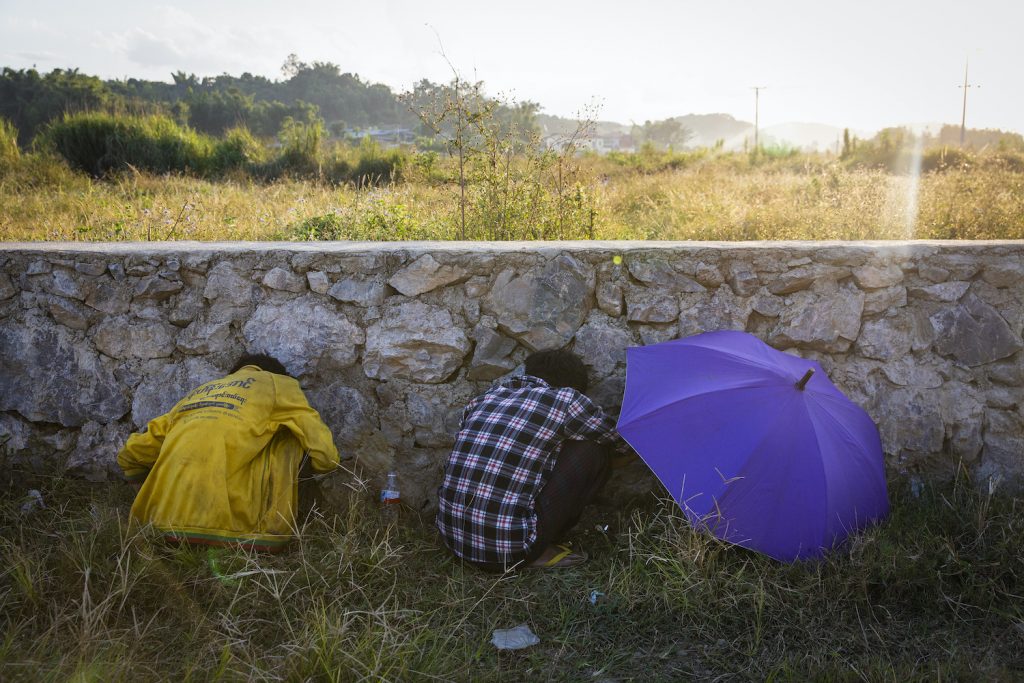
But the TNLA’s anti-drug campaigns remain a major source of tension within the area. The group has not only sought to enforce its drug-free policy among the Ta’ang, but also Kachin and other ethnicities in areas under its control, and has arrested some Kachin who it believes were involved in the trade.
The KIA, too, sometimes faces accusations of bullying towards other ethnic groups. In particular, there are complaints over its recruitment of non-Kachin minorities, sometimes against their will – as evidenced in the abduction of Lway Poe.
Colonel Naw Bu, the group’s spokesperson, said he was only aware of Lway Poe’s case because another media organisation asked him about it previously. “The troops on the ground didn’t report anything about it to us,” he said. “Because it’s on the front line, it might be difficult for them to report it.”
Brigadier-General Tar Bhone Kyaw from the TNLA acknowledged the criticism of the group’s anti-drug activities from other ethnic minorities, who have accused it of using its weapons to bully locals.
“We have more and more soldiers now so we are trying to crack down on illegal drugs in our area of control, but sometimes our soldiers make mistakes towards Kachin and Shan people,” he said.
Regarding La San’s case, Tar Bhone Kyaw said the soldiers had broken the rules and would be punished.
“Whenever we find our soldiers make a mistake, we punish them and sometimes pay compensation … we always admit if we make a mistake.”
But Tar Bhone Kyaw said the narrative that the two groups have existed in harmony is also not quite true, from the Ta’ang perspective.
Traditionally, Ta’ang villagers have been required to provide free labour to Kachin and Shan communities, such as during cultivation time, he said. This customary practice developed because the Kachin and Shan have had strong armed forces and the Ta’ang have not.
“Because our Ta’ang community leaders did not have the courage to make strong decisions, our Ta’ang people have had to live for a long time under Kachin and Shan oppression,” Tar Bhone Kyaw said. “When we have strong armed forces, and we tried to stop bad behaviour towards our people, it’s not surprising that the bullies will be upset.”
If the Kachin and Ta’ang were brothers, to the Ta’ang it always seemed as though the Kachin were the big brother. Now that the TNLA has emerged as a powerful fighting force, the balance has shifted.
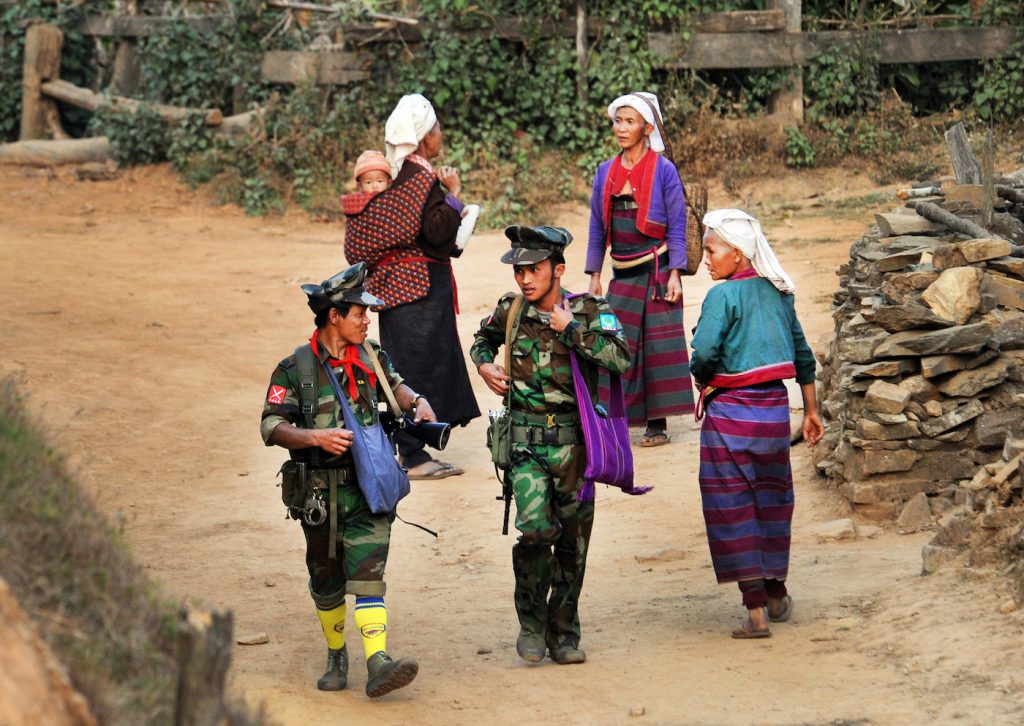
The rise of the TNLA
Fraying ties on the ground reflect the slowly deteriorating relationship between the KIO and the TNLA, particularly as the latter group grows in strength and moves closer to the United Wa State Army.
Although Kutkai is officially in Shan State, many Kachin people regard the area, as well as adjoining Theinni, as part of a larger Kachin sphere of influence, and point to the fact it was known as the “Kachin sub-state” under colonial rule. It was also near Kutkai in 1961 that the KIA was established, before later expanding into Kachin State, and the KIA has always maintained a presence in the region. Many of the area’s pro-government militias are also led by Kachin.
For most of this time since its establishment, the KIA has been allied with smaller Ta’ang armed groups. The Palaung National Front was founded in 1963, two years after the KIA, and both groups soon found themselves facing off against Communist Party of Burma forces, which began moving into the Kachin region of northern Shan State in 1968. The KIA allowed Ta’ang and Rakhine armed groups to use its territory for training, and in 1975 they participated in a joint operation against CPB forces, Martin Smith wrote in Burma: Insurgency and the Politics of Ethnicity.
In January 1976, a former PNF leader formed the Palaung State Liberation Organisation. The following month, the KIA and PSLO signed a formal agreement at the KIO headquarters of Pa Jau, in which they pledged to “fight against the common enemies, particularly the Burmese army”. “Any issues between KIO and PSLO will be solved with peaceful means for perpetual alliance of both organizations … both organisations agreed to [a] perpetual alliance for not only between KIO and PSLO, but also between the Kachin and Palaung peoples,” the agreement said. In a recent opinion piece, Shan State-based political analyst Kodawng Uma wrote that the KIO subsequently provided weapons, financial support and training to the PSLO. Both groups reached a ceasefire with the Tatmadaw in the 1990s, but in 2005 the PSLO, under intense Tatmadaw pressure, surrendered their arms.
As the KIO came under increasing pressure to accept the Tatmadaw’s Border Guard Force plan in the late 2000s, it once again looked to support a new generation of Ta’ang and Rakhine leaders to join the struggle against the Myanmar military. It found them on the border with Thailand, where a remnant PSLO group had been based in Karen National Union territory, and had ignored the group’s decision to surrender.
While KIO patronage would be essential to the formation of the TNLA and its political wing, the Palaung State Liberation Front, as well as the Arakan Army, the men who would go on to found these groups were already casting around for support to get new insurgent groups off the ground.
Since the PSLO surrendered to the Tatmadaw, former members like Tar Aik Bong, now the chair of the PSLF/TNLA, and Tar Bhone Kyaw had remained politically active in Thailand. Officially they were conducting human rights and democracy training in Mae Sot, bringing dozens of men at a time from northern Shan State to the border. At the same time though, they were discussing how they could establish a new armed group – not only to fight back against the Tatmadaw, but also the illicit drugs that were ravaging Ta’ang communities. They approached the KNU for help, but were told that they would need a large amount of money to set up an armed group.
Initially despondent at the KNU response, they instead decided to look to northern Myanmar. There were some factors that made this option attractive: for example, it would be easier for them to infiltrate Ta’ang regions of northern Shan State. When the KIO decided to back the movement, the TNLA was born; around 100 members took part in the first military training, at the KIA Brigade 3 headquarters at Warabong, close to Mai Ja Yang on the Chinese border, in 2009.
In September 2011 – three months after the KIO’s ceasefire with the Tatmadaw broke down – the two groups reprised the 1976 agreement. They agreed to collaborate “to fight against [the] common enemy” and “keep maintaining the perpetual alliance between the Kachin and Palaung peoples”. Once again, the KIO provided a nascent Ta’ang armed group with training, weapons and financial support.
Like the AA, which was also built up through KIO patronage, the TNLA grew steadily over the next decade. For much of the time it fought alongside the KIO; in November 2016, the TNLA, AA, Myanmar National Democratic Alliance Army and the Shan State brigades of the KIA launched deadly attacks on military and civilian targets in northern Shan State, briefly severing the Mandalay-Muse Highway, along which much of the country’s border trade with China passes.
They have also sat beside each other at the negotiating table. Neither the KIO nor the TNLA has an active bilateral ceasefire, and when the Tatmadaw and government sought to negotiate an end to the fighting with the Northern Alliance in December 2018, the four groups insisted on collective talks.
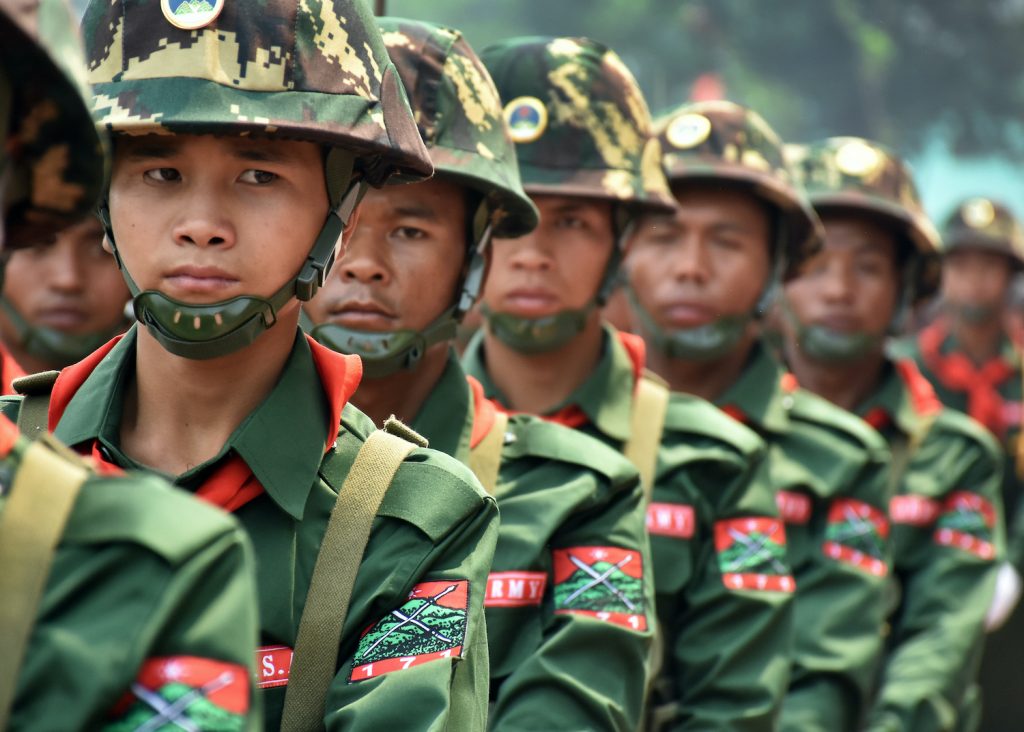
Brothers torn apart
Today, the TNLA has about 10,000 members, Tar Bhone Kyaw says. Its rapid growth in just 11 years has surprised many observers, including the leaders of some other ethnic armed groups.
It is built in part on a TNLA policy that at least one person from every Ta’ang family – usually a man, but sometimes a woman – has to serve in the TNLA. This recruitment policy, along with general instability in northern Shan State over the past decade, has prompted many Ta’ang families to send their children to monasteries in Lashio, Mandalay and Yangon. As Frontier reported last year, about 70 percent of the novice monks and nuns at monastic schools in Yangon are thought to be ethnic minority children from northern Shan State.
In northern Shan State, the TNLA has now become the dominant armed actor. But along with KIO support, the TNLA has benefited from its more recent relationship with the United Wa State Army.
In 2018, the TNLA opened a liaison office at the UWSA headquarters of Panghsang. When the TNLA spearheaded another major attack along the Mandalay-Muse Highway in August 2019, KIO forces did not officially participate; the TNLA, AA and MNDAA instead renamed themselves the Three Brothers Alliance.
The TNLA alliance with the UWSA is based in part on ethnic kinship. The Ta’ang and Wa, along with the Mon of southern Myanmar, speak Mon-Khmer languages. But the UWSA is also more financially powerful than the KIO, and has better access to weaponry through its links with China.
The alliance has unsettled the TNLA’s former patron, the KIO, as well as other armed groups based in Shan State, such as the Shan State Progress Party and Restoration Council of Shan State. By transforming the TNLA into a powerful army, it has also turbocharged Ta’ang nationalism among previously downtrodden communities that had felt vulnerable to both the Tatmadaw and other armed groups.
After news of La San’s beating emerged, some Kachin commentators said the TNLA had shown a lack of gratitude for the assistance that the KIA had provided Ta’ang armed groups over the decades, and was causing problems for Kachin living in Kutkai.
Kodawng Uma wrote on the Kachinland News website that the TNLA has “started to strategise against both KIO and the Kachin peoples across the territories of Kachin in northern Shan State”, and accused the group of carrying out extrajudicial killings, torture, threats and kidnappings against Kachin civilians in northern Shan State since 2017. Although Kachin people have complained to the KIO, the group has responded that the “perpetual alliance” with the Ta’ang should be maintained, he said. Kodawng Uma questioned whether this policy was right. “The atmosphere in the ground reveals that the rank and file of KIA and the Kachin publics in northern Shan state seems to be impatient for not taking actions by the KIO headquarters over the issues of TNLA/PSLF,” he said.
Col Naw Bu was quick to shoot down the suggestion of worsening ties. “We have a good relationship with the TNLA. We have no problem with them,” he said. However, he acknowledged that there may be “occasional misunderstandings and problems between frontline troops” on both sides.
Back in Galeng, La San spent about three days recovering from his beating at the hands of the TNLA. He considered himself lucky, in a way, to have escaped with just bruises. Asked what he thought the incident had revealed about communal relations between the Ta’ang and the Kachin amid a strengthening TNLA, he was reluctant to comment. “I am not criticising them for holding guns and fighting for the freedom of their people,” he said. “But they acted badly towards me and my wife – that’s what I cannot accept.”
This article was supported by The Asia Foundation and UK aid from the UK government via the X-Border Local Research Network. All views are those of Frontier.


